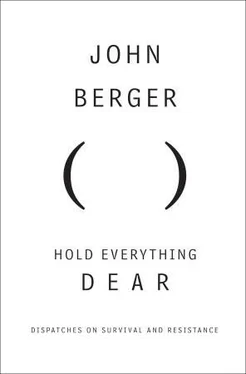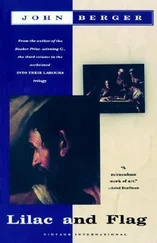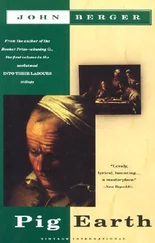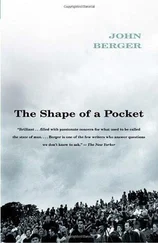Surrounded by the four of them in the sunlight, my attention fixes on their legs, all sixteen of them. Their slenderness, their sheerness, their containment of concentration, their surety. (Horses' legs look hysterical by comparison.) Theirs are legs for crossing mountains no horse could tackle, legs for carrying loads which are unimaginable if one considers only the knees, the shanks, the fetlocks, the hocks, the cannon-bones, the pastern-joints, the hooves! Donkeys' legs.
They wander away, heads down, grazing, their ears missing nothing; I watch them, eyes skinned. In our exchanges, such as they are, in the midday company we offer one another, there is a substratum of what I can only describe as gratitude. Four burros in a field, month of June, year 2005.
10
Yes, I'm still amongst other things a Marxist.
Another Side of Desire (June 2002)
I found an island in your arms,
a country in your eyes,
arms that chain, eyes that lie.
Break on through to the other side.
Jim Morrison
DESIRE. EROTIC DESIRE. The adjective erotic is better than sexual , for it is less reductionist. When desire is reciprocal (between two), the notions of lust, or even libido, become out-dated, for they, by definition, are singular, and not double.
The initial energy of such desire comes of course from the biological need to reproduce. Desire is also an invitation to, and a hope for, imagined pleasures. What begins as erotic desire can be swiftly translated into the desire to have and to possess. The social content of desire is indeed possession , which is why in the theatre unchecked desire is never far from conflict and tragedy.
The potential force of desire is proverbial in all cultures. Perhaps because an awareness of being desired bestows a unique sense of invulnerability, and when this sense is multiplied by two almost anything can be risked.
Desire begins early and continues late. It can occur at all ages between, say, five and eighty. Age may affect the priorities within desire. Yet these priorities are never standard or uniform. Any desire consists of a multitude of offers and wishes, and, finally, there may be as many varieties of desire as there are erotic encounters.
There are nevertheless common ingredients, and what I call another side of desire is, I believe, present in all desire, although the degree of its importance, its recognizability, may vary. In consumer societies this ingredient is seldom acknowledged publicly, except in rock music, where it is often central.
There will always be suffering
It flows through life like water
I put my hand over hers
Down in the lime-tree arbour.
Nick Cave
Desire, when reciprocal, is a plot, hatched by two, in the face of, or in defiance of, all the other plots which determine the world. It is a conspiracy of two.
The plan is to offer to the other a reprieve from the pain of the world. Not happiness (!) but a physical reprieve from the body's huge liability towards pain.
Within all desire there is pity as well as appetite; the two, whatever their relative proportion, are threaded together. Desire is inconceivable without a wound.
If there were any unwounded in this world, they would live without desire.
The conspiracy is to create together a place, a locus , of exemption, and the exemption, necessarily temporary, is from the unmitigated hurt which flesh is heir to.
The human body has prowess, grace, playfulness, dignity, and countless other capacities, but it is also intrinsically tragic — as is no animal's body. (No animal is naked.) Desire longs to shield the desired body from the tragic it embodies, and what is more it believes it can. This is its faith.
There is naturally no altruism in desire. The offer of shielding, of conferring exemption, is made through the offer of the whole self, both physical and imaginative. From the start, two bodies are involved, and so the exemption, when and if achieved, covers both.
The exemption is bound to be brief and yet it promises all. The exemption abolishes brevity — and along with it the hurts associated with the threat of the brief.
Observed by a third person, desire is a short parenthesis; experienced from within, it is a transcendence. In both cases, however, day-to-day life continues around, before and after it.
Desire promises exemption. Yet an exemption from the existing natural order is tantamount to disappearance. And this is precisely what desire, at its most ecstatic, proposes: let's vanish.
Pendant que la maráe monte
(et) que chacun refait ses comptes
J'emmène au creux de mon ombre
Des poussières de toi.
Le vent les portera
Tout disparaîtra mais
Le vent nous portera.
Noir Dásir
The lovers' disappearance cannot be counted as an evasion, a flight; it is, rather, a shift elsewhere: an entrance into a plenitude. Plenitude is usually thought of as an amassing. Desire insists that it is a giving away: the plenitude of a silence, a darkness in which everything's at peace. Somehow I think of the ancient dream, the legend of the Golden Fleece. (It granted an exemption from a sacrifice.) Symbolically it represents both innocence and wisdom. It lies stretched out in its hiding place, curly, inviolate, complete, worn by nobody.
Once shared and experienced, the exemption which no longer exempts remains unforgettable, and the disappearances still seem more true, more precise than what is apparent and legible.
The sirens wail down the street. As long as you are in my arms, no harm will come to you.
Looking Carefully — Two Women Photographers (2005–2006)
1
Ahlam Shibli
(Born in the village of Arab al Shibli, Galilee. 1970.)
FIRST, A DISTINCTION between being simple and simplifying. The former has something to do with reducing or being reduced to the essential. And the latter — simplification — is usually part of a manoeuvre in some struggle for power. Simplifications are self-serving. Most political leaders simplify, whilst the powerless react simply to what is happening. There is often an abyss between the two.
Now let's look at Ahlam Shibli's photographs without making simplifications. They offer, amongst other things, a political lesson and are, in this sense, exemplary. But we'll come to that later. She calls the sequence of pictures Trackers , and this requires an explanation.
There are one million Palestinians today living with official papers, as underclass citizens, in the state of Israel. On their papers they are described as Israeli-Arabs. (If they publicly claim to be Palestinians, they risk a prison sentence.) Among the Israeli-Arabs are Bedouin families.
From these families a small number of men — less than one hundred a year — volunteer to join the Israeli army, where they will be trained and used as military scouts, who are known as Trackers. The trackers, who are exclusively ‘Israeli-Arabs', do much of the army's dangerous field reconnaissance work. It is they who are sent ahead, whenever the Command reckons there may be resistance, to clear a terrain of land-mines, snipers, possible ambushes. The trackers are initially trained together in groups of about twenty or thirty. Once trained, they are separated out and allotted alone to units of the Israeli Defence Force, or the IDF as the army calls itself.
After three years' service, a tracker may volunteer again to become a professional soldier, whereby he will be very much better paid. The IDF Command accepts only a small number of such volunteers. The professional trackers have a professional advantage over Israeli soldiers because of their familiarity with local customs, habits and ways of calculation.
Читать дальше












